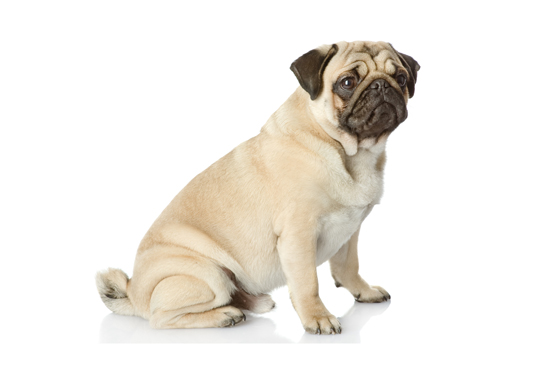Pug Health
Pugs are a sweet and unique breed. Their popularity is no surprise when you see their lovable and sometimes comical faces, with expressive features and proud, curly tails.
The Pug tends to be a relatively healthy breed, but it’s never a bad idea to consider common health problems in a breed before you adopt a dog, so let’s take a look at some of the issues that the Pug could encounter.
Elongated Soft Palate
The soft palate is a soft part in the back of the mouth, and when it grows further back than normal and extends into a Pug's larynx, this is what is referred to as an elongated soft palate. The misplaced palate can block the entrance to the dog's windpipe. It is one of the common reasons that a Pug may have breathing problems.
Symptoms include loud snoring whether awake or asleep, stertor (a low-pitched, gasping noise), excessive panting, trouble breathing during exercise, trouble swallowing, poor oxygenation levels showing as blue gums and/or blue tongue, collapse or fainting in severe cases, and gagging or dry heaving, which is mostly seen in younger Pugs while eating or drinking. Any of these can be exacerbated by excitement or exercise.
 |
 |
A Pug showing signs of Elongated Soft Palate will be closely examined by a veterinarian to check for signs of other possible conditions. This condition is mostly treated with surgery.
Stenotic Nares
Pugs are susceptible to a disease where their nostrils are “pinched”, and the nostrils of the nose are smaller than normal. This makes airflow via the passageway to the lungs more difficult. This condition is very common in the Pug.
This is very easily diagnosed with a simple visual examination, and fixed with surgery that widens the nasal passageways. With puppies, this condition may worsen during the time of teething, so in some cases surgical treatment will be postponed until the Pug has grown out of the teething phase.
Many Pug with this also have the above palate issues. Both issues are often fixed at the same time.
Patellar Luxation
Another disease that may be present at birth in a Pug, but can happen at any time, is Patellar Luxation. Patellar refers to the dog’s kneecap, and Luxation means that the kneecap slips out of place. This condition tends to be present in breeds that weigh less than 25 pounds, but can occur in any dog.
Symptoms include limping, attempting to walk on just three legs to avoid pressure on the hurt knee, and/or raising the leg to communicate that they are in pain. This condition rarely goes away untreated, and the affected leg can develop deformity.
This condition is commonly treated through bed rest and anti-inflammatory medication for mild to moderate cases. Some cases are treated with steroidal medications. If improvement is seen after 3 weeks, exercise is then slowly added with the Pug never being allowed to add too much pressure to the knee than necessary. In recurring or severe cases, surgery is recommended.
Hip Dysplasia
Like many dog breeds, Pugs are highly susceptible to Hip Dysplasia, a degenerative joint disease in which an abnormality involving the hip joint causes it to slip out of place. Most dogs born with this condition initially have normal hips, but due to both genetic and environmental factors, the soft tissues that surround the joint start to develop abnormally as the puppy grows. This growth affects the way that the joint is held together, causing them to move apart instead of staying together.
Puppies as young as 4 or 5 months may be diagnosed with Hip Dysplasia, although, since it is a degenerative disease, clear signs often do not show until a Pug is in his later adult years. Symptoms such as a “bunny hop”, walking funny, trouble rising, trouble with mobility, a narrow stance, intermittent stiffness and eventual loss of muscle tone may be observed.
Treatment can include weight management, controlled exercise and applying warmth. There are several supplements that can help, along with certain medications for both swelling and pain. In some cases, surgery is needed.
Collapsed Trachea
There are rings of cartilage that surround the windpipe. When one or more collapse inward, it is referred to as collapsed trachea.
Symptoms include a very distinct honking sounding cough, which may become worse when the Pug exercises, becomes excited or if the weather is hot and humid. Another symptom is often laboured breathing and the gums can sometimes turn blue due to lack of oxygen. A dog may also have trouble drinking or eating.
Many vets can diagnose this simply by hearing that distinct honking noise. An X-ray can confirm if the tracheal rings have collapsed. Some Pugs can have satisfactory improvement with treatments of anti-inflammatories, cough suppressants, bronchodilators, and/or antibiotics.
When medicine does not help and the condition is grave, surgery can be done to try and correct this. While many types of operations have been done in the past, prosthetic polypropylene rings inserted into the exterior of the dog's trachea is the treatment of choice for most specialists. This has a success rate of 80% and is most successful when the dog is under the age of 6-years-old.
A harness should be used whenever the dog is on leash so that no pressure is put on the neck. This is always recommended for this breed and the use of a harness may prevent this health problem from developing.
Everted Laryngeal Saccules
Pugs can experience swollen membranes on the larynx (laryngeal saccules), causing an obstruction to the airways.
Symptoms are coughing, especially if it’s so severe that it induces vomiting, and trouble breathing. These can develop very quickly. Some Pugs will appear fine and within just a few days, the membranes will swell so badly that surgery will be needed to save the dog's life.
While this may initially be treated with anti-inflammatory medication, moderate to severe cases will need corrective surgery to remove the saccules that are causing the problem. In many cases, a Pug with Everted Laryngeal Saccules also has Elongated Soft Palate and both issues can be corrected at the same time.
Encephalitis
Encephalitis is the medical term for a swelling of the brain. This, in turn, causes seizures, lethargy and loss of muscle control. This is a neurological disorder, which is the leading cause of death for the Pug breed.
This most often strikes Pugs that are between the ages of 2 and 3 years old. This disease presents itself in 1 of 2 forms: Slow progressive and rapid progressive.
When a Pug dog is having a seizure, he may look into space, circle around and around, stumble, breathe very hard, seem confused, be very weak, and in some cases, fall to the ground.
If you suspect that your dog is having a seizure, this should be diagnosed by your dog’s vet right away. Anti-seizure mediction may be used and surgery may need to be performed to control possible swelling of the brain.
General Care
By far, the best thing you can do for your Pug to ensure optimal health is to find a reputable breeder who will complete all available DNA testing to ensure great health before you bring your Pug home. A responsible breeder may very well be more expensive, but he’ll be upfront with testing and the extra money will be well worth it.
Once you bring home your healthy Pug pup, you’ll want to ensure that regular grooming becomes a part of his routine. Because of their large, protruding eyes, Pugs are highly susceptible to foreign objects and debris in their eyes, so check them regularly and carefully as debris may scratch their corneas.
They also have gas issues, due to a sensitive stomach, so you’ll want to ensure you’re providing your dog with a healthy diet – high in protein and fibre – to ensure his body is getting the nutrients it needs to maintain that hard working and energetic lifestyle he loves and thrives on.
Generally speaking, Pugs are loyal, loving, and cuddly little dogs. Doing DNA testing before you bring home your Pug will ensure that, for the most part, your pup stays healthy for the duration of his life.





